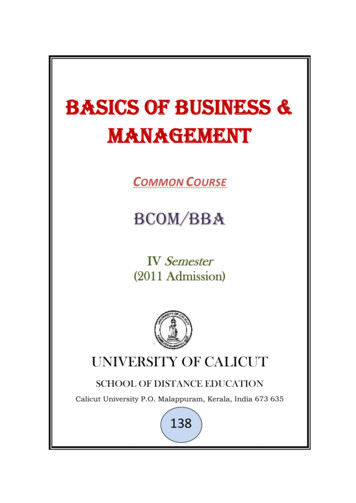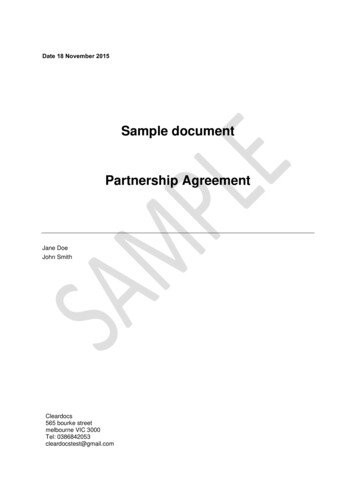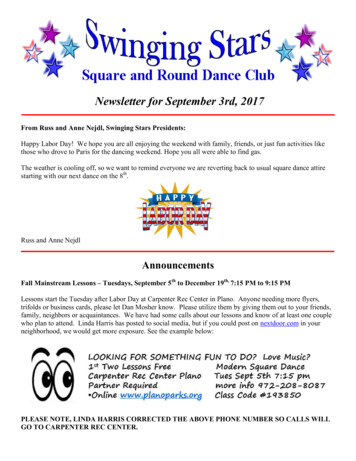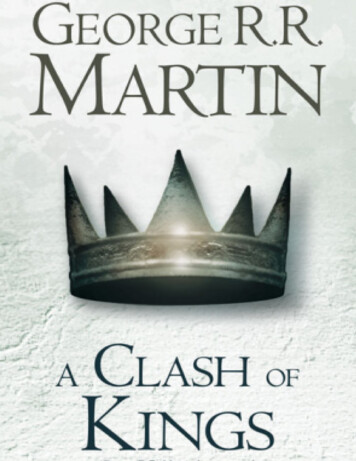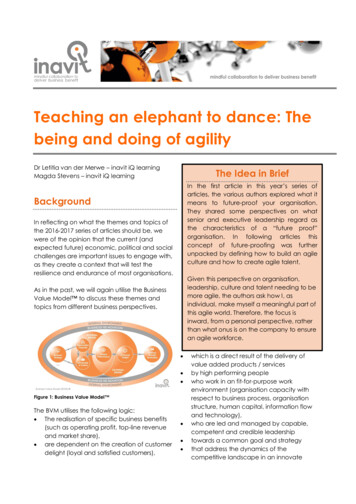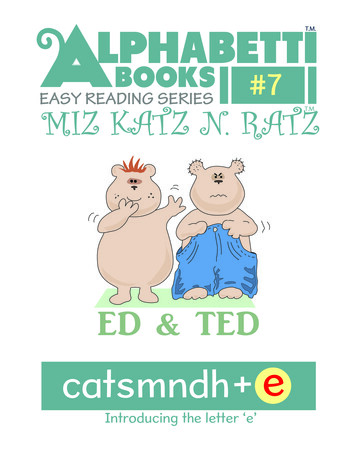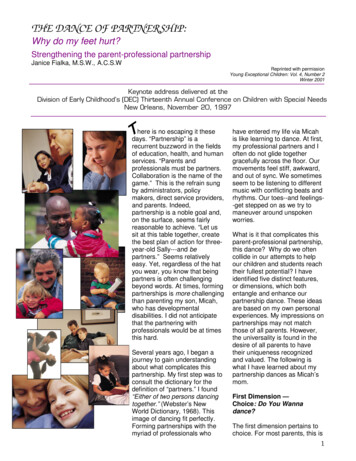
Transcription
THE DANCE OF PARTNERSHIP:Why do my feet hurt?Strengthening the parent-professional partnershipJanice Fialka, M.S.W., A.C.S.WReprinted with permissionYoung Exceptional Children: Vol. 4, Number 2Winter 2001Keynote address delivered at theDivision of Early Childhood’s (DEC) Thirteenth Annual Conference on Children with Special NeedsNew Orleans, November 20, 1997here is no escaping it thesedays. “Partnership” is arecurrent buzzword in the fieldsof education, health, and humanservices. “Parents andprofessionals must be partners.Collaboration is the name of thegame.” This is the refrain sungby administrators, policymakers, direct service providers,and parents. Indeed,partnership is a noble goal and,on the surface, seems fairlyreasonable to achieve. “Let ussit at this table together, createthe best plan of action for threeyear-old Sally---and bepartners.” Seems relativelyeasy. Yet, regardless of the hatyou wear, you know that beingpartners is often challengingbeyond words. At times, formingpartnerships is more challengingthan parenting my son, Micah,who has developmentaldisabilities. I did not anticipatethat the partnering withprofessionals would be at timesthis hard.Several years ago, I began ajourney to gain understandingabout what complicates thispartnership. My first step was toconsult the dictionary for thedefinition of “partners.” I found“Either of two persons dancingtogether.” (Webster’s NewWorld Dictionary, 1968). Thisimage of dancing fit perfectly.Forming partnerships with themyriad of professionals whohave entered my life via Micahis like learning to dance. At first,my professional partners and Ioften do not glide togethergracefully across the floor. Ourmovements feel stiff, awkward,and out of sync. We sometimesseem to be listening to differentmusic with conflicting beats andrhythms. Our toes--and feelings-get stepped on as we try tomaneuver around unspokenworries.What is it that complicates thisparent-professional partnership,this dance? Why do we oftencollide in our attempts to helpour children and students reachtheir fullest potential? I haveidentified five distinct features,or dimensions, which bothentangle and enhance ourpartnership dance. These ideasare based on my own personalexperiences. My impressions onpartnerships may not matchthose of all parents. However,the universality is found in thedesire of all parents to havetheir uniqueness recognizedand valued. The following iswhat I have learned about mypartnership dances as Micah’smom.First Dimension —Choice: Do You Wannadance?The first dimension pertains tochoice. For most parents, this is1
not a chosen relationship. Inspite of the many gifts given tome by the scores ofprofessionals I have metbecause of my son's disability, Iwould rather not know themunder these circumstances. Iwould rather not have a childwith a disability. I did not choosethis.On the other hand, mostprofessionals made a veryconscious choice to work withchildren. Many of you chose thiswork because of a strong senseof connection with these littlepeople, and a passion forteaching. You anticipated thatthis work would give you somesense of meaning to your lifeand a sense of self-esteem andmastery, maybe notevery day, but often.Many of you weredrawn to make adifference in thelives of a child.Let's look at thisissue of choice using this danceimage. Here you are, theprofessional, eagerly awaitingyour new dance partner. Yourarms are stretched out invitingus, parents, to enter your worldof interventions, appointments,activities, forms, and (maybe)hope. You beckon us into yourbrightly decorated offices andclassroom. “Please come in andsee what is here. I’m excited toshare these toys andopportunities. Welcome.”We, as parents, having notchosen this dance, are usuallynot as eager to join you. Wemay approach you not withopen arms but with tightly foldedones clutched to our chest.Sometimes, it is as if our backsare turned to your welcomingarms, eliminating allopportunities for engagement.We may feel reluctant,ambivalent, and often unwilling.For one thing, if we choose tojoin you, we have toacknowledge that our child hasspecial needs. We have toacknowledge that we areentering your world--one that isinitially unfamiliar andfrightening. Entering into ourpartnership with you demandsthat we let go of our dreams andbegin to build new ones. So wemay not appear too eager or toowillingly to join you in thispartnership dance.To your open, welcoming arms,we parents may appeararrogant, withdrawn, hostile,uninvolved, or defensive. Somemight refer to us asbeing “in denial.” Itis easy to see howyou, as theprofessional mightpersonalize ourdistancing attitudewe seem to projectwith our folded arms anddefensive posture. You may findyourself silently crying out to us,“I’m only trying to be helpful!”I recall the story of one motherwhose young son was unable towalk. The idea of a wheelchairwas introduced to the family. Afreshly graduated social workermet this mother ather home eager totake her to selecther son’s firstbrand-newwheelchair. Themother hardlyshared theworker’s enthusiasm. To themother, this was anothershattering of a dream. Shewanted to be selecting a tricyclefor her son, not a wheelchair.One of your tasks as aprofessional is to notpersonalize our distancingattitude, and to understand, thatin most cases, our reluctance toconnect with you and yourprogram is not about YOU, butrather about the situation andcircumstances forced upon us,our families, and our child. Youracceptance and sensitivitytoward our worries and fearshelp to relax our tightly foldedarms. When you can see ourambivalence from our side ofthis partnership dance, thenmaybe you’re less likely to beoffended by our unintended,and sometimes challenging,dispositions. You maybe able tosee that our lack of enthusiasmfor one more meeting, one morephone call, one more form, onemore test, one more transition isless about YOU and more aboutour worries and uncertainties.Second Dimension —Forced Intimacy: Too Closefor ComfortThe second dimension uniqueto our partnership deals withintimacy. Because we are sittingwith you during one of the mostpainful and confusing times ofour life, we feel thrust into anuninvited and awkwardcloseness with you. We sitbefore you at one of our mostvulnerable times.You enter ourhearts. You hearour guilt andshame. You listento ourinadequacies.You are stung byour salty tears. You are witnessto our pain. We may welcomethe tender support and practicalinterventions, but the nature ofthe circumstances forces animmediate intimacy that is2
awkward. At times, it is as if weare forced into a slam-dancepopular among the youngergeneration a few years ago.the hospital in the middle of theThe third dimension to ournight hoping to be reassured bypartnership deals withher warm, rhythmic breathing.identifying who is the partner onHe maneuvered his way through the family side. You asNew York City’s night traffic,professionals often enter thisMost relationships evolverushed through the hospital’swork because you enjoygradually over time. In thislong hallways, shoved open hischildren; you are drawn to theunique parent-professionaldaughter’s door and knelt down“little people.” Additionally yourpartnership dance, we often areclose to her soft cheeks. Heeducation and trainingforced intoburst into sobs asemphasized the child, focusingan instanthe felt her warm,on how to arrive at the properWe may welcome the tenderclosenessreassuringdiagnosis of and intervention forbringing usthe child. Thus, you as thesupport and practical interventions, breaths on hisnose-toface.professional enter this dancebut the nature of the circumstancesnose withready to partner with the child.forcesanimmediateintimacythatstrangersA nurse observed “Let’s dance, little one. You arelong beforeJeff’s unexpected my partner. I’m ready to playis awkward.there is aarrival and laterwith you and teach you. Let’sfoundation of trust to cushionsat next to him offeringbegin together.”the strong feelings. I’m strucksupportive words. Sheby the fact that we parentscommented that she wasParents, however, want andsometimes cry in front of peoplesurprised to see this strongshould be primary partners inwhose last names we don’treaction from him as she hadthis dance. I am reminded of theknow. Our unexpected displaygrown accustomed to hiswords of Kristen Birkmeierof our feelings of sadness, rage, consistent positive attitude.(1993), a physical therapist andor frustration sometimes makes“Jeff, I didn’t know you felt thisnational speaker, as sheit hard to return to your office.way.” She remarked. Jeffaddressed an audience of earlyWe’re not sure what you think of looked at her and responded, “Iintervention therapists. Sheus and our strong emotions.always feel that way. It’s justsaid, “Put the parents first, for itthat I can’t walk around fallingis their lives that have beenMany of us are rather awkwardapart all the time.”changed. The child is who shewith feelings in general. In manyis, and needs your expertise,of our relationships we try toYou as professionals have thebut not without the activeavoid expressing andopportunity to allow us ourinvolvement of the parents whoacknowledging them. I refer tofeelings, even to invite us to “fall live with this child 24 hours afeelings as the “F” word inapart” once in awhile in theday.”partnerships--something topresence of someone whoavoid at all costs. Consider Jeff, understands and cares. Your“Thank you! Thank you!” Ia friend of mine. Jeff’s fourcompassion and nonremember whispering under myyear-old daughter had anjudgmentalbreath as I listened toimmune deficiency problem andattitude can beKristen. I wasPut the parents first, for itwas struggling to stay alive. The a gift thatrecalling Micah’s earlyis their lives that havefamily teetered on the edge ofdecreases ourchildhood days when Ilife and death on a daily basis,sense oftook him to his everybeen changed .”sometimes on a moment-toisolation,Thursday speechmoment basis. One night Jeffsoftens our stress, andtherapy sessions. I would handdecided to spend the evening atdecreases the number of timeshim over to the speechhome away from the hospital,we unintentionally step on toes!pathologist, but I found myselfnow his daughter’s home. Hewishing I could hand me over toThird dimension -hoped for a good night’s sleep,her as well. He needed to learnIdentification of Partners: Willbut was rudely disturbed by ahow to stimulate his oral motorhaunting dream in which histhe Real Partner(s) Pleasemuscles, but I needed to learndaughter died. Her death felt soCome Forward?how to live with a child who didreal to him that he traveled tonot have words or a familiar way3
to communicate his needs.Micah and I both needed todance with our professionalpartner.This rearranging of partners toinclude the parents is oftenawkward and new for theprofessional. It is a shift awayfrom the “old ways” where thefocus was primarily on the childto a more inclusive perspectivewhich invites parents in on thework. For me, some of the mostmeaningful sessions withMicah’s therapists were theones when the professionalsmomentarily put aside the big,green, bouncy ball and turned tome to ask, “What are youconcerned about? What havewe neglected to think about forMicah? How are you doing?”Those questions felt wonderfuland truly engaged me in thispartnership dance.Another aspect to this thirddimension deals with the sheernumber of partners. Earlier Istated that the definition ofpartners was “either of twopersons dancing together.” Aswe all know, we are not talkingabout a partnership of two whendealing with ourchild. On theparent’s sidethere may betwo, but morelikely there areothers, includingsignificant lovedones, siblings,extended familymembers, andfriends. On the professionalside, there’s the speechtherapist, the occupationaltherapist, the physical therapist,the social worker, the teacher,the nurse, the paraprofessional,and on and on. I didn't just givebirth to Micah; I gave birth to anentire ballroom. And at any time, cheek-to-cheek makes all theany one of those partners cansense in the world. All partnerschange faces, as thedo not need to be at everyprofessionals move in and out of dance, at every meeting.jobs orKnowingassignments.whichThere are times when a large squareSometimes wedance is needed and other times when meetingsare dancing withshould bedancing cheek-to-cheek makes all themore peoplesmall andsenseintheworld.than iswhichmanageable.should involve the entire team isanother way to reduce theI am a strong proponent ofamount of times that toes getmeetings that include allstepped on. Sometimes more ismembers of the team. It is innot better.this setting that the creativeFourth Dimension —problem solving is invigoratingRole Expectations: Who’sand reassuring. At our recentschool meeting to plan for myLeading This Dance?son, one teacher learned fromanother teacher ways to involveThe fourth dimension is the lackhis peers in assisting Micah with of clarity to our distinct roles;written assignments. Then, thethat is, who is leading thisspeech therapist offeredpartnership dance. Historically,suggestions about new software based on the medical model,to enhance his participation andthe professionals were viewedwe, his parents, reminded theas the experts. They lead thisteam about the importance ofdance. They gave the directionusing current events to engageto the dance and decided on theMicah in the class discussions.music. Now we hear more talkThe partnership dance wasabout parents being the experts.working!"Parents know their child best."In many ways, I agree with thisNot all meetings of the entireapproach. My husband and I doteam flow this evenly, however.know a tremendous amountNegotiation with twoabout Micah, especially nowpeople can bethat we’ve been his parents forchallenging, but with16 years. We know what grabseight, nine or ten ithis attention---politics andcan feel cumbersomesports. We know he oftenand unproductive.repeats himself when he wantsSometimes it makesto keep your attention andsense to meet withdoesn’t know what else to say.only two or threeWe know that he needsmembers, especiallycoaching about ways to engagewhen the issues arehis peers. We know that he hasvolatile or complicated. Most ofan exquisite ability to readus talk more freely and riskpeople’s moods and respondsharing our worries when wewith compassion and insight.work with fewer people.At the same time, there is soThere are times when a largemuch that we still don't knowsquare dance is needed andand understand about him andother times when dancinghis mind, especially as we face4
his future as an adult. There areso many processes that are notclear to us. Our uncertainty wasmore prominent during his earlychildhood years. I was lesslikely to trust my “motherinstinct.” During those earlyyears, when professionals usedthat well-meaning but patphrase “You are the expert, Ms.Fialka,” my mind would go asblank as a freshly cleanedchalkboard and I would shiver atmy inability to say somethingprofound or at least coherent. Inthe beginning I knew moreabout what he didn’t do, thenwhat he could do. For me theuse of the phrase “You are theexpert” pulled me away from myfamiliar role of everyday-momwho giggled with Micah as wesplashed in the bath tub, andinstead shoved me behind theprofessional’s desk piled highwith thick reports and foreignacronyms. “Expert? What doyou mean by that?”I prefer to move away from thisidea of expert and in its placeuse the word contributor. Eachdancer, professional and parent,contributes to the understandingof the child. Our uniquecontributions evolve and buildon each other as we offerdiffering sides and perspectivesabout this child. There is theplayground-side, the art classside, the dinnertime-eating-side,the bouncing-on-daddy’s-kneeside. Each of our contributionsis critical. Ann Hartman (1993)captured this spirit when shewrote to professionals, “Wemust relinquish the role ofexpert so that our clients’narratives and experiences canbe validated. . . .We do notdiscard our knowledge, wecease to privilege it, and weapply our knowledge withcaution and humility, with therecognition that it is one of manytruths. . .”A square dance comes to mindas I see the partners circling inand around, over and throughthese many “truths,” relying onthe hand of the next partner toguide us to the next place in ourdance.Fifth Dimension —Differing Priorities: Do YouHear What I Hear?The fifth dimension deals withpriorities. Priorities for parentsand professionals often differ. Itis as if we each have on ourown set of headphones and arelistening to our own music withits own tune, words, and rhythm.There's the mother-song, thefather-song, the speechpathologist-song, theneurologist-song, and theteacher-song. Sometimes theonly song we can momentarilyagree on is “Hit the road Jack,and don’t you come back nomore, no more!”“Some days it is pleasant.” Itentatively continued. “But moredays than not, that sweet,unknowing girl is the constantreminder of what Micah can’tdo, no matter how muchexercising, and pushing andpulling of his low muscle tonearms and legs we do! Manydays that innocent girl is areminder of our lost dream.”The teacher consultantmaintained her eye contact withme and respectfullyacknowledged my perspective.“I never thought about it thatway. I’m glad that youmentioned it to me. You helpedme to see your world.” Theteacher consultant, in essence,took off her professionalheadphones, put on my parentheadphones and listened to mymusic and words. Thisinteraction reminds me that aspartnership-dancers we must bewilling to take risks, offer ourheadphones to our partners andbe willing to listen to eachother’s music and experiences.We won’t be able to do it all ofthe time, but when we can, Ibelieve we will be more effectivein strengthening the parentprofessional partnership.When Micah was about twoyears old, a teacher consultantmade weekly visits to our homefor “fun and therapy!” Onebeautiful spring day, we decided When the physical therapistto playsuggests to aEach dancer, professional and mother that sheoutdoors. Aswe moved tobegin helping herparent, contributes to theour backchild focus onunderstanding of the child.lawn, we sawproper handour next door neighbor and herpositioning of eating utensils, ityoung daughter playing outsideis critical that the therapist alsoon their swing set. The teacherbe mindful that this seeminglyconsultant, noticing that the little innocent recommendation maygirl seemed to be about thewreak havoc during the familysame age as Micahmeal time. When making newcommented, “It must be nice torecommendations to families,have a playmate for Micah rightone therapist asks the family anext door.”series of questions, “Now that Ihave suggested some newI understood her thinking, butapproaches at home, what haveoffered my own experience.I missed? How will this change5
or disrupt your life? How willthis complicate your daily living?What do I need to understandfrom your side as the parent?”toes, when we feel we’d rathernot be at this dance--at thismeeting--then it is time toexamine these five issues todetermine which one mightneed to be further explored orThis type of questioningaddressed. The issue is not willrespectfully invites parents toshare their music,thesetheir perspective sodimensions as partnership dancerscreep into ourthatwe must be willing to takepartnerships,recommendationscan be relevant,because theyrisks, to offer ourpractical, andobviously will.headphones to our partners The issue ismanageable. Thisare we willinggives the messageand be willing to listen toto recognizeto parents that “Ieach other’s music andneed d be courageous enough todiscuss them and work on themThese five dimension--choice,together.forced intimacy, partnershiproles, number of partners, andMaybe our theme song for ourpriorities--are present in all ourpartnerships should at leastdances, in all our parentprofessional partnerships. When begin with the refrain, “Gettingwe are experiencing difficulties,to know you, getting to know allabout you.” I believe that ifwhen we step on each othersparents and professionals are tobe effective in creatingmarvelous opportunities for ourchildren, then both sets ofpartners must carve out time toget to know each other’sdreams, hopes, fears,constraints, and perspectives.We must take off our own setsof headphones and be willing tohear each other’s music, withspecial attention to andinclusion of the parent’s musicand unique dance steps. Totruly get to know the child, wemust also get to know eachother, not just as parents andprofessionals (more labels) butas people. This is hard workrequiring patience, trust, andlots of getting to know eachother, as well as ourselves. It isone of the most significant waysthat we can make a difference inthe lives of our children who areindeed the star dancers of thisrelationship.ReferencesBirkmeier, K. (1993). Nurturing and empowering the family while treating the child with a disability. Presentation for Project REACH Early On,Pontiac, MI.Hartman, A. (1993). The professional is political. Social Work, 38 (4), 365-366.Webster’s new world dictionary (College ed.). (1968). Cleveland, OH: The World Publishing Company.NotesThe author would like to acknowledge Carolyn McPherson and Karen Mikus for their valuable insights, editorial comments, and support. Inaddition, the author extends a heartfelt thank you to the many parents and professionals who have shared their partnership stories.You can reach Janice Fialka at ruaw@aol.com or com6
forces an immediate intimacy that is awkward. Put the parents first, for it is their lives that have been changed .” awkward. At times, it is as if we are forced into a slam-dance popular among the younger generation a few years ago. Most relationships evolve gradually over time. In this unique paren
